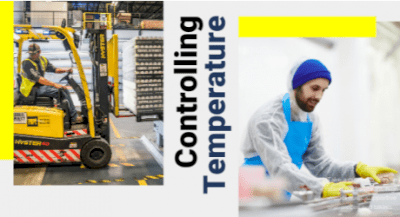Control the internal temperature in your factory/warehouse
Traffic going in and out of the building means large openings are often left open. This drops the internal temperature of the building dramatically in the winter or raises it in the summer.
This can have a major impact on the processes inside of the factory. Temperature fluctuations in a food factory could cause goods to spoil, or wood to warp when manufacturing wood products. Not only that, but workers inside the factory can be affected by poor conditions.
Here are the top 3 tips to control the internal temperature in your building
1. Check your doors
One of the easiest ways to raise internal temperature in a warehouse in winter is to keep doors closed when not in use. Unfortunately, this is not possible in heavy traffic areas such as loading bays where a standard roller shutter is installed. A roller shutter can take too long to open and close. It also does not have the capability to perform multiple operations per hour. The shutter is then left open causing cold/hot air to enter the building, counteracting any heating/cooling systems in place.
Installing a high speed door is a simple solution to this. The fast vertical operation of a high-speed roll-up door helps conserve heat inside a building in colder climates. When air conditioning is installed it will contain the cool air within the building in warmer climates. The fast automatic open and close action also helps facilitate a through flow of traffic to increase productivity. High-speed doors like Hart’s Speedor Storm can be used with a roller shutter to maintain security at night. And maintain internal temperatures during the day when a shutter is left open exposing the building to the elements.
2. Improve airflow within the building
It is a challenge to maintain a steady airflow inside of a building due to large open spaces, high ceilings and buildings that have more than one opening. Improving the way air moves through your building can make a substantial difference to the overall climate in your facility.
In processes where specific temperatures are required such as the food industry or manufacturing, the best option to combat this is to compartmentalise the building. Internal high-speed doors work at higher operating speeds than a roller shutter or sectional overhead door. They can sustain a high number of opening and closing cycles over a long period. The compartmentalisation serves to reduce air currents within a building to improve working processes.

3. Install heaters/coolers
Placing heaters or air conditioning units in areas where there are workers is a great way to ensure the employees are comfortable in their working conditions. For areas that have constant cold spots, the best solution may be to add more heaters such as new radiant heaters that are efficient and create enough heat for large spaces.
It is important to carry out Step 1 before embarking on steps 2 and 3, as these are counterproductive without addressing where the troubling airflow is coming from in the first instance.

To get the best out of your door, a site survey to assess the conditions on site is recommended to ensure the door is fit for purpose.
We can help you choose the best industrial doors for your premises.

